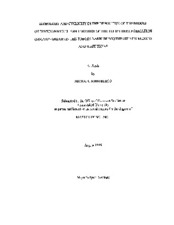| dc.creator | Bosco, Michael John | |
| dc.date.accessioned | 2012-06-07T22:54:59Z | |
| dc.date.available | 2012-06-07T22:54:59Z | |
| dc.date.created | 1999 | |
| dc.date.issued | 1999 | |
| dc.identifier.uri | https://hdl.handle.net/1969.1/ETD-TAMU-1999-THESIS-B67 | |
| dc.description | Due to the character of the original source materials and the nature of batch digitization, quality control issues may be present in this document. Please report any quality issues you encounter to digital@library.tamu.edu, referencing the URI of the item. | en |
| dc.description | Includes bibliographical references (leaves 48-51). | en |
| dc.description | Issued also on microfiche from Lange Micrographics. | en |
| dc.description.abstract | The lower Paleozoic rocks deposited on the inner craton of North America are characterized by thick sections of carbonate rocks separated by thin units of sandstones and shales. The origins of these sandstones are poorly understood, but it is generally agreed upon that they were deposited in a near shore environment during a relative withstand in a shallow epicontinental sea. One of these sandstones, the McKee Sand, having a maximum thickness of approximately 230 feet in the Tobosa Basin, appears to be abnormally thick to have been deposited during a single sea-level withstand event. Therefore, the McKee was deposited as a result of several smaller progradational withstands and transgressions as opposed to a single higher order withstand event. Changes in quads sand grain size and percentage of clay and carbonate composition accompanied by sharp breaks and repetition in facies delineate this cyclicity. The McKee Sand is largely composed of sandstones, muddy sandstones, and sandy mudstones. The sandstones are generally subquartzose to quartzite (50 to 100%), moderately well-sorted and very tine to fine grained. Very fine to medium sand-sized detrital cellophane is sometimes common (<16%), as are tassels, but feldspars In the McKee are rare (<2%) making the McKee sandstones overall quartz arenites. Medium sand to cobble gravel-sized, rounded to well-round, mudstone rock fragments are locally abundant and often deformed. Four facies can be distinguished in the McKee Sand based on sediment lithology and sedimentary structures. Cyclic breaks in lithology occur above tidal flat or tidal channel facies (facies 3 and 4 respectively) at the maximum flooding surface. Above the maximum flooding surface lies the most basinward facies either the inner shelf facies (facies 1), or more commonly the wave-dominated beach facies (facies 2). In general, a sequence in the McKee Sand consists of the most basinward facies overlain by progressively landward facies. A composite sea-level curve showing this cyclicity can be extrapolated from this information. | en |
| dc.format.medium | electronic | en |
| dc.format.mimetype | application/pdf | |
| dc.language.iso | en_US | |
| dc.publisher | Texas A&M University | |
| dc.rights | This thesis was part of a retrospective digitization project authorized by the Texas A&M University Libraries in 2008. Copyright remains vested with the author(s). It is the user's responsibility to secure permission from the copyright holder(s) for re-use of the work beyond the provision of Fair Use. | en |
| dc.subject | geology. | en |
| dc.subject | Major geology. | en |
| dc.title | Lithology and cyclicity in the deposition of the Middle Ordovician McKee Sand member of the Tulip Creek Formation (Simpson Group) in the Tobosa Basin of Southeast New Mexico and West Texas | en |
| dc.type | Thesis | en |
| thesis.degree.discipline | geology | en |
| thesis.degree.name | M.S. | en |
| thesis.degree.level | Masters | en |
| dc.type.genre | thesis | en |
| dc.type.material | text | en |
| dc.format.digitalOrigin | reformatted digital | en |


